Technology
Services
Resources

Once considered a soft option for PPC advertising, Bing Ads now offers a wide array of opportunities for advertisers to reach their desired audiences and drive meaningful revenue. Last year we published some tips and secrets on how to expand your SEM strategy using Bing Ads. Since then, the platform has undergone a lot of changes. For one, Bing Ads rebranded as Microsoft Advertising, and that’s just the tip of the iceberg. They also launched a plethora of new features to help advertisers improve campaign performance and grow ROI. If you want to maximize the value of Bing Ads for SEM in 2020, here are 13 new tips and strategies to consider.
Bing allows you to import your Google Ads account and campaigns over to its platform. While this makes it incredibly easy to get started with Bing SEM, it does, however, mean that few marketers actually set about the task of optimizing their campaigns for Bing Search. That’s why it’s important to take advantage of Bing’s own research functionalities to generate targeted changes and get a head start over your competition.
For example, Bing Ads has its own Keyword Planner tool that marketers can use to build unique keyword lists. Bing’s audience is very different from Google’s, and so select search queries will be more or less relevant and elicit a different search volume on Bing versus Google. Bing’s Keyword Planner comes with some unique features, such as allowing you to build negative keyword lists. It also shows statistics and suggestions with up to six months worth of historical data.
Microsoft Ads just launched a series of new features that make it easier to manage shopping campaigns using Microsoft Advertising Scripts. Smart advertisers can utilize these functionalities to save time and optimize campaigns more effectively. The new “list view”, for instance, makes it possible to filter, sort, and pivot Product Groups to make bulk changes.

You can also easily view performance data side-by-side and enable percentage-based bid changes.
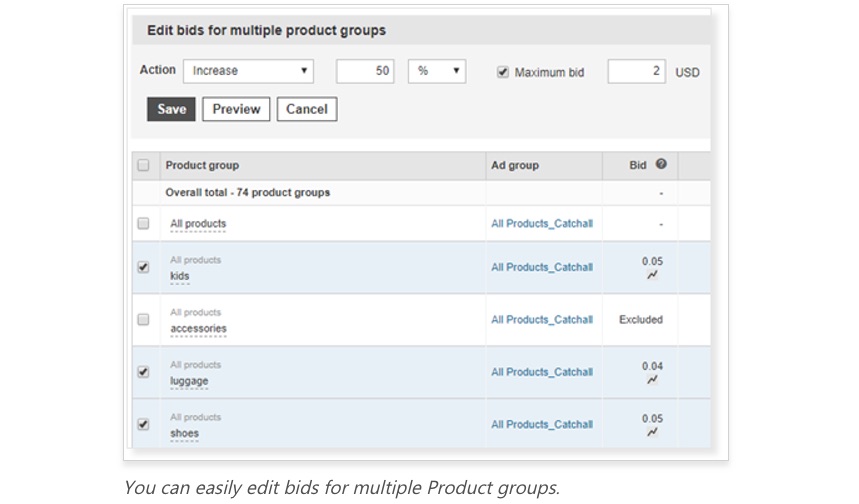
Microsoft Advertising takes a novel approach by displaying performance data alongside Product Group subdivisions. This makes it easy to see how different categories are performing so you can make smart decisions when setting up your groups. If you’re looking to enhance the performance of your Bing Shopping campaigns, this is a good place to start.
Bing has been making lots of changes to incorporate the same valuable feature sets into their shopping campaigns as Google Ads. Sponsored Products, as an example, came to Bing Ads last April, allowing manufacturers to increase the visibility of their products in search results and drive more traffic and conversions in the process.
According to Bing Ads representatives: “With this new capability, our clients can achieve better alignment of marketing efforts between manufacturers and retailers. Together, the connections they create with shoppers work harder to drive performance - clicks, conversions, and ROI.”
Microsoft Advertising Editor is a unique campaign management tool. It’s a desktop application that enables you to make changes to your campaigns online or offline, empowering you to save time by making bulk changes to your campaigns, ads, and keywords. You can manage ad copy, extensions, URLs, budgets, bids, targeting, and more.
It’s possible to manage multiple accounts from the interface and you can copy and paste elements from one account to another. It also includes keyword research tools so you can discover new keywords and add them to your campaigns quickly and easily.
Using negative keywords is a great way to ensure your ads don’t appear for irrelevant search queries. Often, advertisers compile negative keywords into large lists that they share across related campaigns. This can sometimes create problems when a negative keyword you add for one campaign could block ads from showing for relevant queries in another.
To help marketers address this issue, Bing created the Product Negative Keyword Conflicts Report. It shows you which of your product ads are blocked by negative keywords as well as their match type. The “Conflict Level” functionality will also detail at what level the conflict arose.
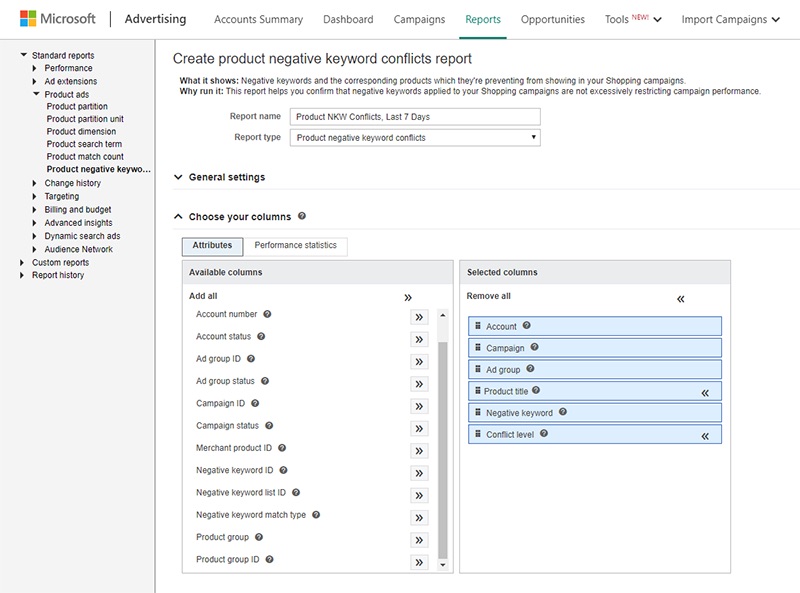
You never know when negative keywords from a shared list might be blocking your ads from showing for relevant queries. The Product Negative Keyword Conflicts Report can help you make sure your negative keywords are always working to improve the performance of individual campaigns.
After a few months of beta, Microsoft Advertising rolled out Responsive Search Ads for everyone in January 2020. They report that early adopters are seeing, on average, a 10% increase in volume, a 6% rise in CVR, and a decrease in CPA of 7%.
Similar to Google Ads, Responsive Search Ads allow you to set 3 - 15 ad headlines and 2 - 4 descriptions. Bing artificial intelligence will then automatically select the most relevant combination for each search query, ultimately ensuring you’re always targeting your audience with the most pertinent message for their interests, needs, and intent.
In April 2019 Bing Ads released a new ad extension format called Action Extensions. These are completely unique to Bing. Action Extensions allow advertisers to add 70 different calls-to-action to their ads, such as “Browse,” “Visit Store” or “Free Quote.” Advertisers can easily experiment with all the varying options to determine which ones generate more clicks and engagement. Here’s an example of what they look like on desktop search:

Local Inventory Ads are a new ad type that help brick-and-mortar businesses showcase their local inventory and retail store information within their ads. Bing uses local store inventory information and displays relevant product ads to users who are near a store’s location. Those who click on the ad are directed to the Bing storefront where they can view store location, product availability, and other helpful information:
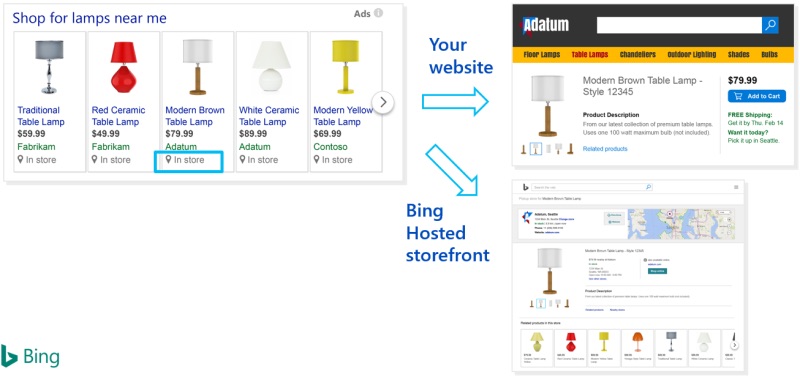
Local Inventory Ads are a valuable option because they deliver relevant information to potential customers. They also can help you get more clicks or foot traffic to your physical locations.
Copious busy advertisers tend to simply mirror their Google Ads optimizations on Bing. That’s a great place to start, but Bing has a unique audience and unique search features to employ if you’re looking to deliver peak performance. The new Bing Ads Recommendations tab can help with this. It has filters to narrow your focus on the elements that matter most, such as Repairs, Bids & Budgets, Keywords & Targeting, and Ads & Extensions. Here’s an overview of what it looks like:
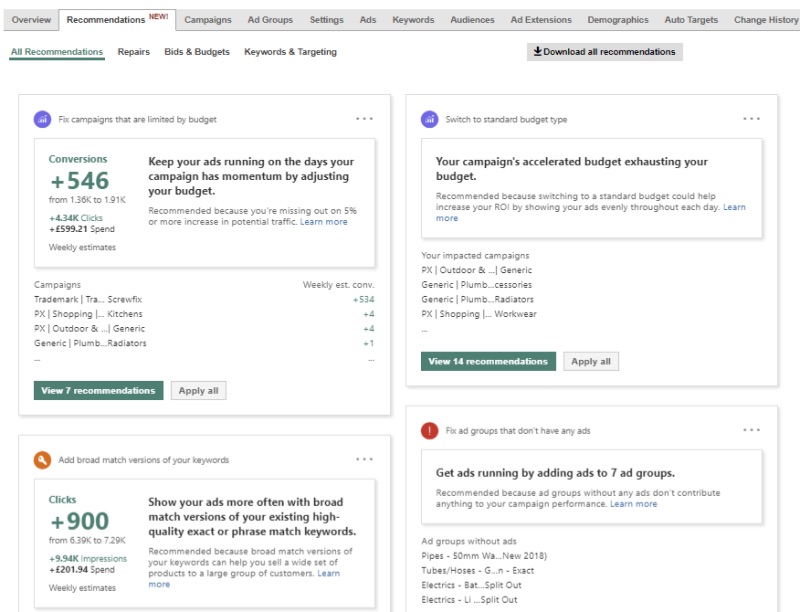
This tab doesn’t just offer suggestions, though; it also explains the reasoning behind specific improvements, making it easier for advertisers to make informed decisions about the optimizations they make. If you feel like you don’t have time to optimize your Google Ads and Bing campaigns separately, then these AI-driven insights are a great tool to utilize.
Like Keyword Planner, Auction Insights is another feature that advertisers pay attention to on Google Ads yet ignore on Bing Ads. It can help you understand how your ad performance compares to competitors. Metrics like impression share, average position, and outranking share show if you need to make improvements to your ads or bids to perform better in auctions. Tracking campaign changes and using Auction Insights metrics will help you understand if your content strategy resonates with your target audiences as well.
For a long time, Google Search audience targeting was very sophisticated while Bing trailed behind. In September 2019 that all started to change. Bing Ads released audience targeting solutions that empower advertisers to connect their own company data with relevant keywords and demographics.
Product Audiences is a new targeting option that creates remarketing lists for specific products you’re advertising. This feature dynamically pairs customers with products based on products they’ve looked at in the past. Using Product Audiences is extremely valuable as you can target people who have a clear purchase intent.
Similar Audiences is another option that automatically finds new customers who have similar interests to your existing remarketing lists. This allows you to expand your audience targeting to more relevant prospects, increasing conversions and ROI in the process.
If you’re advertising on Google and Bing simultaneously, you need to be very conscious of budget spending. Shared Budgets is a great tool that allows you to assign a single budget to multiple campaigns on Bing.
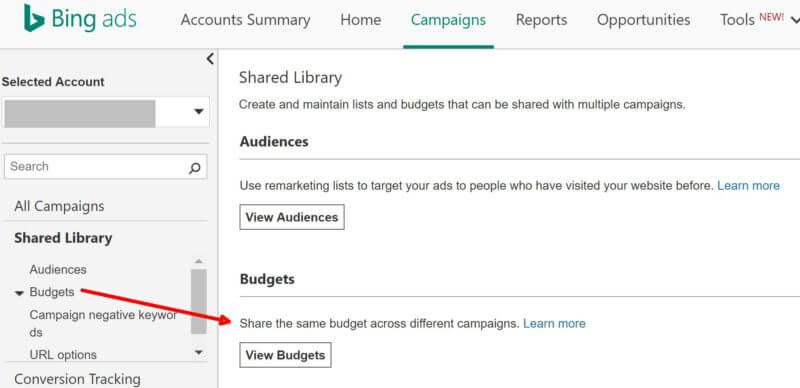
Why is this valuable? Different campaigns don’t utilize the same budget at the same pace or bring the same return. You need to strategically allocate your spend otherwise certain campaigns will finish their budget when they could have spent more, while others could end up with a surplus. This functionality automatically distributes marketing dollars to the campaigns that need it and ensures you’re always spending strategically across your entire SEM program.
Social Extensions are another tool unique to Bing Ads. They’ve been around for quite some time, but still, only a few marketers take advantage of them. Social Extensions appear under your ad copy in search results, directing your audience to social conversions on platforms like Facebook, Twitter, and Instagram. They are a great option for advertisers who want to nurture leads and encourage engagement with audiences who might not yet be ready to convert. You can use social extensions alongside other ad extensions to increase engagement while also targeting other goals, like CTR.
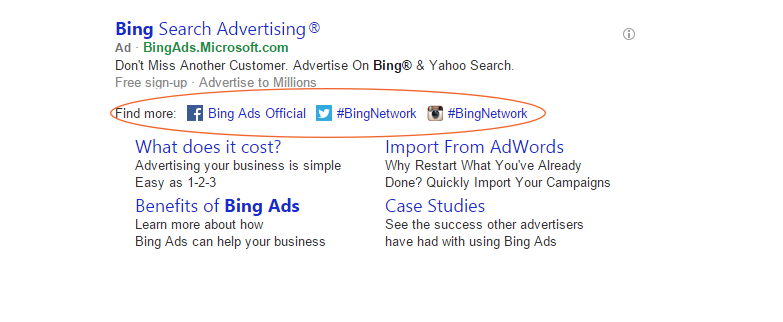
Bing Ads has made a great many changes that have made it easier to expand your SEM strategy beyond Google Search. Now they’re starting to develop new features and capabilities that allow advertisers to maximize their revenue potential.
Mirroring your Google Ads strategy on Bing is a great approach when you first start out on the platform, but performance marketers should be prepared to develop a unique blueprint for Bing PPC using all the most valuable tools and resources. Start taking advantage of these 13 features today and keep an eye out for new opportunities to drive ROI with future developments from Microsoft Advertising.